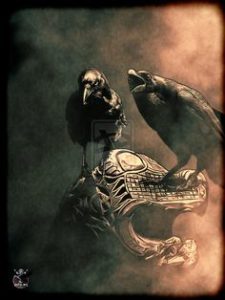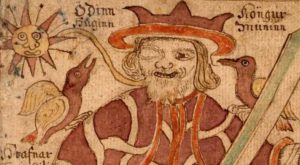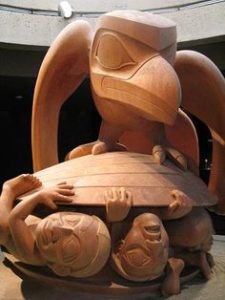I’ve been immersed in the myths of the North for months now, writing a novel on how these stories might interact with and relate to each other, through the lens of my protagonist Astrid.
One part of the novel that I’ve had a lot of fun with have been the ravens that appear there. Odin’s ravens Huginn and Muninn are characters, as well as the Haida god Raven. I have one scene in which Muninn and Raven have a conversation with each other, and it’s one of my favorites of the entire novel.
Ravens hold an interesting place in the mythologies of the people of the North, which I would like to explore a little bit today. Huginn and Muninn are Odin’s companions and helpers in the Norse tradition, flying to the ends of the earth to bring back information to whisper in his ear. The word Huginn is Old Norse for “thought”, and Muninn is Old Norse for “memory,” or “mind.” From the Prose Edda we learn that Odin was called the “Raven God” due to his association with these two forces of nature. Much like Athena and her owl, Odin is often recognized by the raven perched nearby.
Some scholars believe that the presence of ravens signifies ties to shamanic practices, which would have found their way from their Siberian home to the world of the Norse and Germanic peoples. Odin is known for his wisdom, much of it acquired from Huginn and Muninn’s messages. One can easily extrapolate out the role of the ravens as being related to the projection into the spirit world that is the shaman’s role.
In the Haida tradition of the Pacific Northwest, Raven holds a much grander role in the mythos of his people. Raven is a Creator God, bringing essentials such as the Sun into the world, as well as creating people for the first time.
In this sculpture, which occupies a place of honor at the Museum of Anthropology in Vancouver, Raven is coaxing his new creations out from the safety of their clam shell, urging them to come out and play.
The Raven of the Native American tradition was considered a trickster god, as well as holding ties to shamanic practices, as alluded to earlier in this post. Ravens live deep in the human imagination, and I can’t wait for the world to see how I’ve worked with raven symbolism and myth in my novel.




I’m trying to edit my novel on a modern myth – well, set in the 60s – where Raven is a character – hopefully I’ve also incorporated this into the story along with other mythic elements